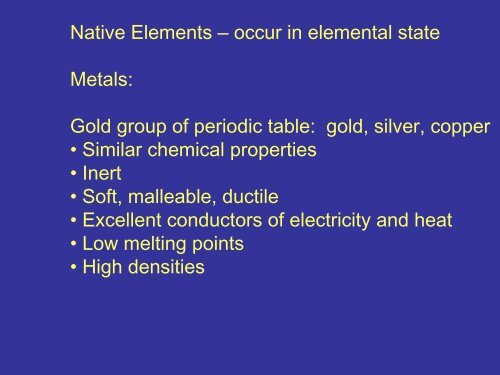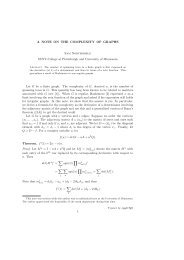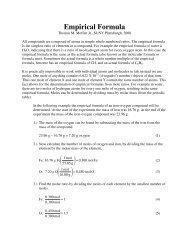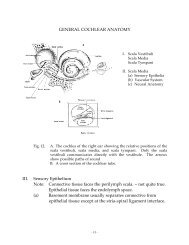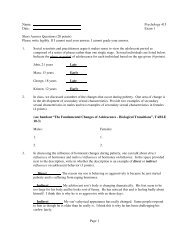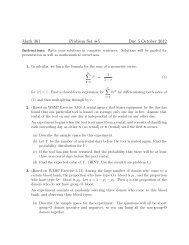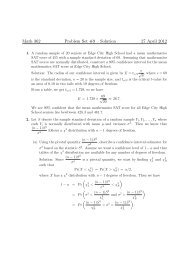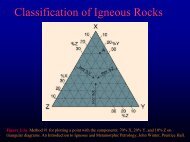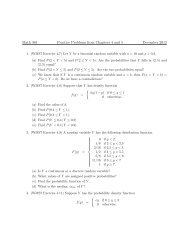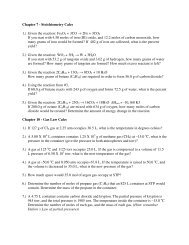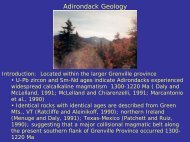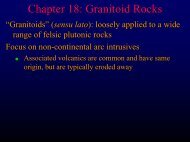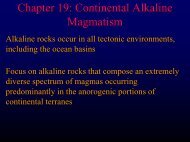Native Elements, Sulfides, Halides, Sulfates - Faculty web pages
Native Elements, Sulfides, Halides, Sulfates - Faculty web pages
Native Elements, Sulfides, Halides, Sulfates - Faculty web pages
You also want an ePaper? Increase the reach of your titles
YUMPU automatically turns print PDFs into web optimized ePapers that Google loves.
<strong>Native</strong> <strong>Elements</strong> – occur in elemental state<br />
Metals:<br />
Gold group of periodic table: gold, silver, copper<br />
• Similar chemical properties<br />
• Inert<br />
• Soft, malleable, ductile<br />
• Excellent conductors of electricity and heat<br />
• Low melting points<br />
• High densities
Gold - Au<br />
Silver - Ag<br />
Copper - Cu
<strong>Native</strong> <strong>Elements</strong> - Non-metals<br />
Sulfur – S<br />
Orthorhombic, yellow<br />
Poor conductor of heat<br />
Burns easily<br />
Absence of good cleavage<br />
Graphite – C<br />
Hexagonal, metallic luster<br />
Greasy feel<br />
1 direction of cleavage<br />
H = 1-2
<strong>Native</strong> <strong>Elements</strong> - Non-metals<br />
Polymorphs<br />
Diamond - C<br />
Isometric<br />
Octahedral xstals<br />
Strongly bonded structure<br />
Each C atoms covalently<br />
bonded to 4 C neighbors<br />
Graphite – C<br />
Hexagonal, metallic luster<br />
Greasy feel<br />
1 direction of cleavage<br />
H = 1-2
<strong>Sulfides</strong>: Majority of ore minerals<br />
Most opaque with distinctive colors and streaks<br />
Galena - PbS<br />
Isometric<br />
Cubic xstals and cleavage<br />
Metallic luster<br />
High S.G. = 7.4-7.6<br />
Occurrence:<br />
1) hydrothermal veins;<br />
2) Mississippi Valley deposits<br />
Sphalerite - ZnS<br />
Isometric, yellow to brown<br />
Massive form also tetrahedrons,<br />
cubes<br />
Yellow streak; Zn ore<br />
Occurrence:<br />
1) veins in igneous rocks<br />
2) Mississippi Valley deposits
<strong>Sulfides</strong>: Majority of ore minerals<br />
Most opaque with distinctive colors and streaks<br />
Pyrite – FeS 2 ; Isometric<br />
Cubic xstals with striated faces; also pyritohedrons and octahedrons<br />
Metallic luster; conchoidal fracture; Greenish-black streak<br />
Most common and widespread sulfide mineral<br />
Occurrence:<br />
1) Accessory mineral in igneous, metamorphic and sed rocks<br />
2) Mississippi Valley deposits<br />
3) Other sulfide deposits
<strong>Sulfides</strong>: Majority of ore minerals<br />
Most opaque with distinctive colors and streaks<br />
Chalcopyrite – CuFeS 2 ; Tetragonal<br />
Massive or tetragonal tetrahedron xstals<br />
Metallic luster; brass yellow to iridescent; Greenish-black streak<br />
Cu ore – most widely occurring<br />
Occurrence:<br />
1) Chief Cu mineral at Sudbury, Ont. and high T deposits<br />
2) Mississippi Valley deposits<br />
3) Cu-porphyry deposits
<strong>Sulfides</strong>: Majority of ore minerals<br />
Most opaque with distinctive colors and streaks<br />
Cinnabar – HgS; Hexagonal<br />
Massive or fine granular; Hg ore<br />
Vermillion red; scarlet streak<br />
High S. G. = 8<br />
Occurrence: few localities<br />
Vein fillings near recent volcanic<br />
rocks and hot springs<br />
Molybdenite – MoS 2<br />
Hexagonal; foliated or massive<br />
1 direction of cleavage<br />
Metallic luster; blue-gray color<br />
S.G. = 4.6; similar to graphite<br />
Occurrence: 1) hydrothermal<br />
veins; 2) accessory in granites,<br />
pegmatites: 3) contact metamorphic<br />
deposits
<strong>Halides</strong>: Dominated by halogen ions, Cl, Br, F, I<br />
High symmetry forms<br />
Halite – NaCl; Isometric<br />
Cubic xstals; transparent luster<br />
Salty taste<br />
H = 2.5; S. G. = 2.16<br />
Occurrence: Evaporite occurring<br />
in extensive beds and irregular<br />
masses<br />
Fluorite – CaF 2<br />
Isometric; cubic xstals<br />
Octahedral cleavage<br />
Vitreous luster; color varies<br />
H = 4; S.G. = 3.2<br />
Occurrence: 1) hydrothermal<br />
veins; 2) accessory mineral in<br />
igneous rocks and pegmatites
<strong>Sulfates</strong>: contain SO 4<br />
2-<br />
Anhydrous<br />
Anhydrite – CaSO 4<br />
Orthorhombic; massive<br />
H = 3; S. G. = 2.9<br />
Vitreous luster; colorless to blue<br />
or violet<br />
Occurrence: associated w/salt<br />
deposits; amygdules in basalt<br />
Not common<br />
Barite - BaSO 4<br />
Orthorhombic; tabular habit<br />
Barite roses<br />
Vitreous luster; colorless -white<br />
H = 3; S.G. = 4.5<br />
Occurrence: common; hydrothermal<br />
veins<br />
Used as heavy mud in oil/gas<br />
industry
<strong>Sulfates</strong>: contain SO 4<br />
2-<br />
Hydrous<br />
Selenite<br />
Gypsum – CaSO 4 2 H 2 O<br />
Monoclinic; most common sulfate: xstals tabular or diamondshaped<br />
H = 2; S. G. = 2.3; scratches w/fingernail<br />
Vitreous luster; colorless to white; 3 unequal cleavages not at<br />
90°; varieties – satin spar, selenite, alabaster<br />
Occurrence: common in sed rocks; evaporite deposits<br />
Used in sheetrock and plaster of Paris


